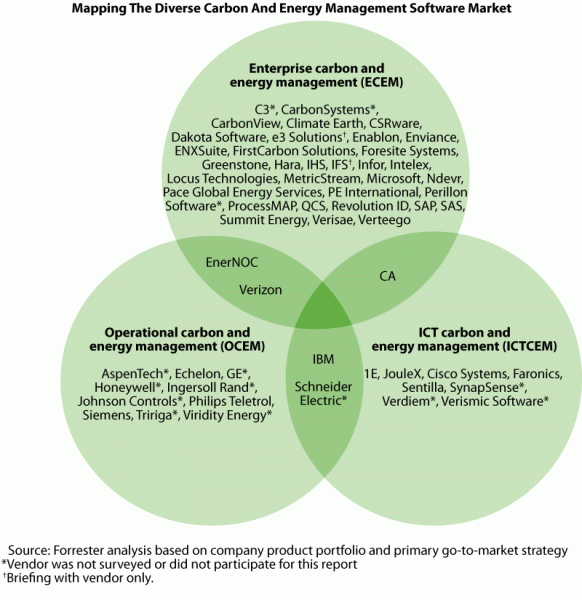The Evolution Of Enterprise Carbon And Energy Management Software
Forrester just published my comprehensive research report (approx. 40 pages) on the current state and future prospects for enterprise carbon and energy management (ECEM) software. We surveyed more than 40 suppliers, did interviews and demos with more than 20, and drew upon our ongoing discussions with consultants, service providers, and of course enterprise buyers that are participating in the takeoff phase of the ECEM market. One of the interesting takeaways from our research is that the carbon and energy management market is actually three market segments, not one (see figure below):
- ECEM software targeting executive/business levels — the most crowded segment today. These solutions are geared to help executive and line-of-business management monitor, analyze, and manage energy consumption, as well as related carbon emissions and energy consumption, across operational or functional silos. These systems act as aggregators of energy consumption information coming from various sources, and they use embedded carbon calculation methods to automate carbon emission analyses. Today, we find a highly diverse field of players in this market, where the number of vendors is increasing on a weekly basis. Large enterprise software suppliers like CA, SAS, and SAP are vying with EHS specialists like Enablon and IHS, and with pure plays like Enviance, ENXSuite, Hara, PE International, and Verisae. However, there are also a number of energy management service providers such as Climate Earth, FirstCarbon Solutions, Foresite Systems, and Summit Energy, which offer ECEM software but primarily use these as platforms for offering ECEM as a fully outsourced service. We call this platform-based environmental intelligence/analytics and consulting services, which is similar to platform business process outsourcing (BPO) services.
- OCEM software is the domain of large industry players.These solutions are primarily proprietary systems that monitor and control energy-intensive systems like heating, ventilating, and air conditioning (HVAC) in facilities. Hence, OCEM is primarily used at the facility and operations management level to control and manage the energy usage of distinct facilities or production assets. These systems are less integrated with other systems and do not provide sophisticated intelligence and analytics capabilities. Furthermore, these systems primarily track energy consumption, with little or no focus on carbon emissions.
- ICTCEM software is characterized by data center and PC power management solutions. These solutions help IT management to monitor and control energy consumption of ICT assets. The vendors’ solutions focus primarily on the data center (e.g., by vendors such as 1E, IBM, Sentilla, and SynapSense) and the PC (e.g., 1E, Faronics, Verdiem, and Verismic Software). As in OCEM, these solutions primarily focus on energy usage and do not have embedded carbon functionality.

As sustainability continues to climb on the corporate strategy agenda of enterprises, the imperative to track, manage, and disclose carbon emissions will become embedded into the nervous system — and software backbone — of most companies.
We're looking forward to tracking this market as it evolves, and welcome your input and questions.
Best,
Daniel